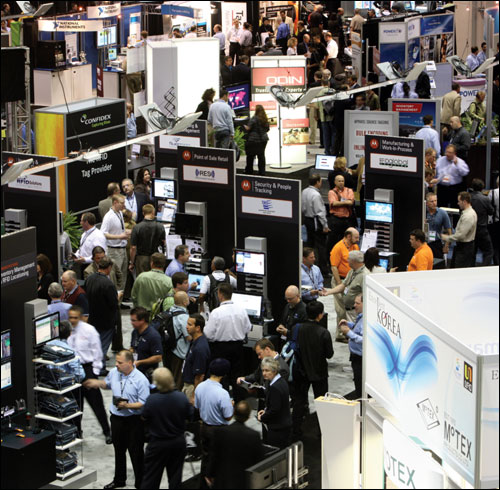Each year, RFID vendors, users, researchers, academics, and others gather at RFID Journal LIVE! to conduct business, form partnerships, network and take soundings on the state of the radio frequency identification technology industry. As such, the event is a barometer of industry progress and the technology’s potential to improve the way companies do business. And each year, the event takes on a slightly different tone and focus.
In 2009, the industry gathered during the depths of the recession, when companies were putting RFID projects on hold to conserve cash. Still, about 2,500 people attended the event, including a number of end users interested in deploying the technology.

When the RFID community gathered in Orlando, Fla., this April, the economy had improved—or at least stopped slipping—and the mood was a little brighter. We didn’t need quite as big an exhibit hall as in previous years—several small vendors had gone under, and some large companies took smaller booths to stay within tighter marketing budgets—but there were more paid attendees, perhaps due to a growing interest in using RFID to cut costs and improve efficiencies, relaxed travel budgets or both.
The makeup of attendees was also different. In the past, people representing consumer packaged goods companies accounted for 5 percent to 9 percent of attendees. This year, they accounted for just 1 percent. This reflects a shift away from the original emphasis on using Electronic Product Code (EPC) technology to improve the retail-CPG supply chain toward using all kinds of RFID technologies to achieve internal benefits.
Manufacturers continued to make up the largest portion of attendees (13 percent), but there was an increase in people from the aerospace sector (5 percent, up from 2 percent last year), health care (7 percent, up from 1 percent), and military and defense (9 percent, up from 4 percent). As in the past, more than half the attendees were from companies with 1,000 employees or more.
Many attendees were focused on finding asset-tracking solutions, and more were interested in deploying RFID across their enterprises—to track assets, people and products. In a post-event survey, more than half of all end users (53 percent) said their primary reason for attending the event was to meet vendors that could solve their business problem, compared with 37 percent who came to hear how others in their industry are using RFID. Eighty-four percent said they plan to purchase technology from exhibitors they met.
The attendees seemed to accept that RFID systems work effectively when a system is designed properly. There was less discussion of tags and interrogators, and more about applications and vertical industry solutions. Microsoft and Motorola, both major sponsors of the event, participated in panel discussions with partners that had developed solutions for specific industries.
Diana Hage, CEO of RFID Global Solution, spoke on the Motorola panel about a solution designed to help banks and other institutions manage their IT assets. “We built out a platform called Visi-Trac, which is really focused on corporate asset tracking in general, and we focused on classes of assets that either had a high volume of turns or were high value,” she told the audience. “Then we looked at where there were significant compliance or audit requirements, which required a lot of labor to collect the data. Then we built the solution specifically for the IT data center market. We have 120,000 tagged assets at Bank of America.”
Xterprise CEO Dean Frew described his company’s solution for tracking reusable transport items, commonly used to move parts and raw materials through the global supply chain. “Most companies are currently operating at 60 to 65 percent asset utilization, and they are writing off anywhere from 10 to 20 percent and buying new ones,” he said. “Someone is writing a check for that every year. RFID can solve that problem and deliver business value.”
Frew also explained the business value Xterprise’s solution creates for apparel retailers. “It helps retailers get beyond the 70 percent to 80 percent inventory accuracy they are currently living with,” he said. “That’s a big problem that RFID can help solve.”
Many exciting, new hardware products were showcased in the exhibit hall. And there were more companies exhibiting software solutions, many of which can be hosted remotely, lowering upfront deployment costs.
Overall, it appears RFID has reached a maturity level at which hardware innovations make the technology easier to deploy and software solutions turn the data into information companies can use to improve the way they do business.
Innovation on Tap
The following 10 technology providers were finalists for the Best in Show Award at this year’s RFID Journal Awards, which recognizes the best new product exhibited at LIVE! 2010. Impinj won the award.
Awarepoint: Its ZigBee-based Real-time Awareness Solution includes sensors that plug into standard electricity wall sockets.
Franwell: The RFID Sleeve WR100 is a wearable RFID reader that collects data as workers handle boxes.
IDS Microchip AG: The IDS-SL900A EPC Class 3 microchip contains a fully integrated temperature sensor.
Impinj: Its Monza 4 tag chip family improves read rates and data security.
Motorola: The MC3090-Z is a lightweight, high-performance handheld reader.
Murata: Its Magic Strap LXMS series of antennaless RFID tags can be incorporated into products for authentication and short-range identification.
Omni-ID: The Omni-ID Ultra, a passive ultrahigh-frequency tag, has a read range of up to 35 meters (115 feet) on, off or near metals and liquids.
TagSense: Its ZT-500 active tag houses multiple sensor inputs and has a one-mile range.
Tego: The TegoTag-Beyond ID platform uses high-memory tags to store information about assets and make that data available whenever and wherever needed.
Voyantic: Its Tagformance RFID measurement system verifies that tags operate properly and qualifies how well they function.
Photo: Tom Hurst

